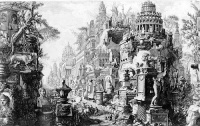Ancient Rome
From The Art and Popular Culture Encyclopedia
| Revision as of 18:58, 8 January 2008 Jahsonic (Talk | contribs) ← Previous diff |
Revision as of 16:27, 20 April 2008 Jahsonic (Talk | contribs) Next diff → |
||
| Line 1: | Line 1: | ||
| - | [[Image:Tepidarium Lawrence Alma-Tadema.jpg|thumb|right|200px|''In the [[Tepidarium]]'' ([[1881]]) - [[Sir Lawrence Alma-Tadema]]]]{{Template}}: | + | [[Image:Tepidarium Lawrence Alma-Tadema.jpg|thumb|right|200px|''In the [[Tepidarium]]'' ([[1881]]) - [[Sir Lawrence Alma-Tadema]]]] |
| + | [[Image:Antichità Romane.jpg|thumb|right|200px|The late [[Baroque]] works of [[Claude Lorrain]] and [[Salvatore Rosa]] had featured [[romantic]] and [[fantastic]] depictions of [[ruin]]s; in part as a [[memento mori]] or as a [[reminiscence]] of a [[golden age]] of [[architecture]]. [[Piranesi]]'s reproductions (see right) of real and [[fictitious]] [[Roman Empire|Roman]] ruins were a strong influence on [[Neoclassicism]]. ]]{{Template}} | ||
| :''The deification of Antinous, his medals, statues, temples, city, oracles, and constellation, are well known, and still dishonor the memory of Hadrian. Yet we remark, that, of the first fifteen emperors, Claudius was the only one whose taste in love was entirely correct.'' --[[Edward Gibbon]] | :''The deification of Antinous, his medals, statues, temples, city, oracles, and constellation, are well known, and still dishonor the memory of Hadrian. Yet we remark, that, of the first fifteen emperors, Claudius was the only one whose taste in love was entirely correct.'' --[[Edward Gibbon]] | ||
| '''Ancient [[Rome]]''' was a [[civilization]] that grew from a small agricultural community founded on the [[Italian Peninsula]] circa the [[9th century BC]] to a massive [[empire]] straddling the [[Mediterranean Sea]]. In its twelve-century existence, Roman civilization shifted from a [[monarchy]], to a [[Roman Republic|republic]] based on a combination of [[oligarchy]] and [[democracy]], to an [[autocracy|autocratic]] [[Roman Empire|empire]]. It came to dominate [[Western Europe]] and the entire area surrounding the [[Mediterranean Sea]] through [[invasion|conquest]] and [[cultural assimilation|assimilation]]. | '''Ancient [[Rome]]''' was a [[civilization]] that grew from a small agricultural community founded on the [[Italian Peninsula]] circa the [[9th century BC]] to a massive [[empire]] straddling the [[Mediterranean Sea]]. In its twelve-century existence, Roman civilization shifted from a [[monarchy]], to a [[Roman Republic|republic]] based on a combination of [[oligarchy]] and [[democracy]], to an [[autocracy|autocratic]] [[Roman Empire|empire]]. It came to dominate [[Western Europe]] and the entire area surrounding the [[Mediterranean Sea]] through [[invasion|conquest]] and [[cultural assimilation|assimilation]]. | ||
Revision as of 16:27, 20 April 2008

|
Related e |
|
Featured: |
- The deification of Antinous, his medals, statues, temples, city, oracles, and constellation, are well known, and still dishonor the memory of Hadrian. Yet we remark, that, of the first fifteen emperors, Claudius was the only one whose taste in love was entirely correct. --Edward Gibbon
Ancient Rome was a civilization that grew from a small agricultural community founded on the Italian Peninsula circa the 9th century BC to a massive empire straddling the Mediterranean Sea. In its twelve-century existence, Roman civilization shifted from a monarchy, to a republic based on a combination of oligarchy and democracy, to an autocratic empire. It came to dominate Western Europe and the entire area surrounding the Mediterranean Sea through conquest and assimilation.
The Roman empire went into decline in the 5th century A.D. The western half of the empire, including Hispania, Gaul, and Italy, broke into independent kingdoms in the 5th century. The eastern empire, governed from Constantinople, is usually referred to as the Byzantine Empire after 476, the traditional date for the "fall of Rome" and for the subsequent onset of the Early Middle Ages, also known as the Dark Ages.
Roman civilization is often grouped into "classical antiquity" with ancient Greece, a civilization that inspired much of the culture of ancient Rome. Ancient Rome contributed greatly to the development of law, war, art, literature, architecture, technology and language in the Western world, and its history continues to have a major influence on the world today.
Symbols
One of the symbols of Rome is the Colosseum (70-80), the largest amphitheatre ever built in the Roman Empire. Originally capable of seating 50,000 spectators, it was used for gladiatorial combat. The list of the very important monuments of ancient Rome includes the Roman Forum, the Domus Aurea, the Pantheon, the Trajan's Column, the Trajan's Market, the Catacombs of Rome, the Circus Maximus, the Baths of Caracalla, the Arch of Constantine, the Pyramid of Cestius, the Bocca della Verità.

